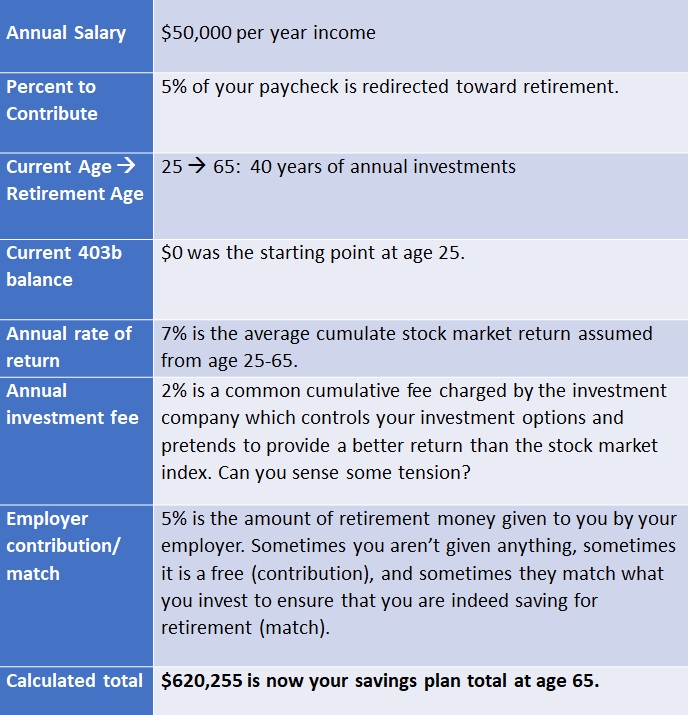
How to Efficiently Save For Retirement
We all owe gratitude to a job that provides a paycheck to support yourself, your family, and the economy. Some of that pay is dedicated to state taxes, federal taxes, social security, life insurance, healthcare plans, etc, and there is a chance some is invested toward retirement. Sometimes a company matches a percentage invested up to 3–6%, and usually we select that percentage to invest toward retirement without much thought. Eventually, we assume that we will retire, and our retirement will be supported.
The table below shows an example of an individual investing 5% (+5% employer match) of a $50K income over 40 years. A standard stock index return of 7% with a low annual investment fee of 0.10% would yield a retirement account totaling $1,008,000. Certain companies including Vanguard (my personal favorite) and TIAA (in rare situations) do offer plans with similar fees, but most retirement investment partners including Voya and Valic have fees with closer to a 2% minimum (read the fine print!). These 2% fees would have costed you about $388,000. Rather than a $1,008,000 retirement account, the value would be closer to $620,000.

Vanguard offers index investment options with fees in the area of 0.05 – 0.40%. Another investment company with similar options may also be a good choice. The most important take-home message:
Find all the investment fees associated with your current plan.
School systems are often heavily influenced to partner with companies like Valic and Voya. These companies often provide Vanguard or other index stock options with annual investment fees presented as something close to 0.35%. Within the official paperwork it is a bit harder to find the fact that all accounts are subject to an annual investment fee of 1.25%. This means that the low fee Vanguard option is great, but you are still paying 1.6% of investment fees. Rather than ending $388,000 dollars short of potential investment gains with the 2% fees, the best investment option within the overarching company would still cost you close to $350,000 with their 1.6% fees.
But investment advisors within these companies have reassured me…
You are in a safe location with plenty of growth potential.
Your investments are outperforming ‘insert other random comparisons here’.
Fees are this ‘insert a low number here’ which is better than ‘insert another random comparison here’.
Don’t forget to remain paranoid. Low fee index options are bad because at one random time the market dropped 50% in this 4 month period and it will probably crash again soon.
I have heard those arguments, and I learned a few things since then. High fee investment options usually contain several index investments anyway. They may not crash as hard as an index only fund when the market crashes, but they probably won’t profit as well as the index either. Over a period of 30–40 years, the ‘studious’ investment analysts may perform slightly better than the index, but the annual fee they require drops your investment gain potentials more than they are willing to admit. The flashy numbers and graphs selling their product rarely includes the annual investment fees when predicting potential investment gains. Is this costing you slightly less or significantly more than $388,000?
If you are unsure, here is a link to bankrate retirement calculators.
There are times when only one company is selected, and your investment options are limited. If your company’s chosen investment partner is funding vacations and dinners for your company’s finance department, you are probably funding vacations and dinners for your company’s finance department. That being said, a $620,000 retirement plan yield is better than a $0-dollar retirement plan. Social norms have prioritized ‘owning’ large houses (via mortgage), and nice vehicles (via loan) over long-term investing. When nothing is invested toward retirement, fee details become a moot issue.
A savings account investment plan would be slightly better than the previously mentioned 0-dollar retirement plan option. Investing $5000 (5% of 50K + 5% employee match) per year in savings account with a 0.25% return will result in a figure closer to $210,000. Considering the employee match isn’t going to happen, that number will actually be closer to $105,000. Succumbing to excessive annual investment fees would still leave you with more money than conservatively stockpiling your cash at a local bank ($620,000 is indeed greater than $105,000).
Take home point: Invest toward retirement. But if you see hundreds of advertisements promoting your investment company and/or your financial advisor is driving a luxury SUV, find somewhere else to invest.
Please leave a comment, and let the debate begin!
2 COMMENTS
Well said! I can’t believe it took me 2 years to see this post! I’ll also add that http://www.bogleheads.org is a good place to learn more about low cost, index fund investing. I can’t recommend it enough.
Thanks Ryan! Bogleheads is a great reference and most of those conversations are easy to digest. I learned most of what I know through my friend who has the same name as you (by sheer coincidence of course), as well as the book, ‘John Bogle on Investing’
Comments are closed.